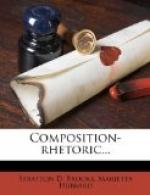+90. Development of a Composition by Comparison or Contrast.+—The third method of development is that of comparison or contrast. Nearly every idea which we have suggests one that is similar to it or in contrast with it. We are thus led to make comparisons or to state contrasts. When these are few and brief, they may make a single paragraph (Section 48). If our comparisons or contrasts are extended, they may make several paragraphs, and thus a whole theme may be developed by this method.
In such a theme no fixed order of presentation is determined by the actual occurrence in time or space of that which we present. Consequently, in outlining a theme of this kind, we must devote special attention to arranging our paragraphs in an order that shall give coherence and emphasis.
+Theme XLVIII.+—Write a theme of three or more paragraphs developed by comparison.
Suggested subjects:—
1. Compare men with verbs
(active, passive, transitive, intransitive,
defective,
redundant, auxiliary, copulative, etc.).
2. Show that the body
resembles a machine.
3. In what way is the
school like a factory?
4. How do two books that
you have read differ?
5. Compare Lincoln and
McKinley. How alike? How different?
6. How can you tell an
oak tree from an elm tree?
7. Without naming them,
compare two of your friends with each other.
8. Compare the advantages
and disadvantages of public high schools
with
those of private academies.
+91. Development of a Composition by Use of Generalization and Facts.+— Using the fourth method of development, we may give an entire composition to the explanation of the meaning of a general proposition or to the demonstration of the truth of such a proposition. To accomplish this purpose we state facts or instances that illustrate the meaning of the proposition or that show it to be true. In such a composition each important fact or instance may be given a separate paragraph, while several minor facts or illustrations may be properly combined in the same paragraph. (See Section 44.) Greater emphasis may also be given the more important facts by assigning them to the emphatic positions.
Notice how by specific instances the following selection illustrates the truth of the generalization set forth in the second sentence and restated in the last sentence.
DEGENERATION THROUGH QUIESCENCE
While parasitism is the principal cause of degeneration among animals, yet it is not the sole cause. It is evident that if for any other reason animals should become fixed, and live inactive lives, they would degenerate. There are not a few instances of degeneration due simply to a quiescent life, unaccompanied by parasitism.




